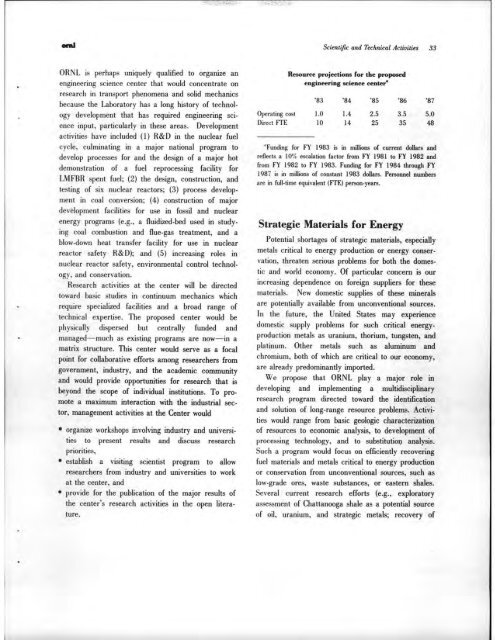Oak Ridge National Laboratory Institutional Plan: FY 1982-1987
Oak Ridge National Laboratory Institutional Plan: FY 1982-1987
Oak Ridge National Laboratory Institutional Plan: FY 1982-1987
Create successful ePaper yourself
Turn your PDF publications into a flip-book with our unique Google optimized e-Paper software.
ORNL is perhaps uniquely qualified to organize an<br />
engineering science center that would concentrate on<br />
research in transport phenomena and solid mechanics<br />
because the <strong>Laboratory</strong> has a long history of technol<br />
ogy development that has required engineering sci<br />
ence input, particularly in these areas. Development<br />
activities have included (1) R&D in the nuclear fuel<br />
cycle, culminating in a major national program to<br />
develop processes for and the design of a major hot<br />
demonstration of a fuel reprocessing facility for<br />
LMFBR spent fuel; (2) the design, construction, and<br />
testing of six nuclear reactors; (3) process develop<br />
ment in coal conversion; (4) construction of major<br />
development facilities for use in fossil and nuclear<br />
energy programs (e.g., a fluidized-bed used in study<br />
ing coal combustion and flue-gas treatment, and a<br />
blow-down heat transfer facility for use in nuclear<br />
reactor safety R&D); and (5) increasing roles in<br />
nuclear reactor safety, environmental control technol<br />
ogy, and conservation.<br />
Research activities at the center will be directed<br />
toward basic studies in continuum mechanics which<br />
require specialized facilities and a broad range of<br />
technical expertise. The proposed center would be<br />
physically dispersed but centrally funded and<br />
managed—much as existing programs are now—in a<br />
matrix structure. This center would serve as a focal<br />
point for collaborative efforts among researchers from<br />
government, industry, and the academic community<br />
and would provide opportunities for research that is<br />
beyond the scope of individual institutions. To pro<br />
mote a maximum interaction with the industrial sec<br />
tor, management activities at the Center would<br />
organize workshops involving industry and universi<br />
ties to present results and discuss research<br />
priorities,<br />
• establish a visiting scientist program to allow<br />
researchers from industry and universities to work<br />
at the center, and<br />
provide for the publication of the major results of<br />
the center's research activities in the open litera-<br />
Operating cost<br />
Direct FTE<br />
Scientific and Technical Activities 33<br />
Resource projections for the proposed<br />
engineering science center"<br />
"Funding for <strong>FY</strong> 1983 is in millions of current dollars and<br />
reflects a 10% escalation factor from <strong>FY</strong> 1981 to <strong>FY</strong> <strong>1982</strong> and<br />
from <strong>FY</strong> <strong>1982</strong> to <strong>FY</strong> 1983. Funding for <strong>FY</strong> 1984 through <strong>FY</strong><br />
<strong>1987</strong> is in millions of constant 1983 dollars. Personnel numbers<br />
are in full-time equivalent (FTE) person-years.<br />
Strategic Materials for Energy<br />
Potential shortages of strategic materials, especially<br />
metals critical to energy production or energy conser<br />
vation, threaten serious problems for both the domes<br />
tic and world economy. Of particular concern is our<br />
increasing dependence on foreign suppliers for these<br />
materials. New domestic supplies of these minerals<br />
are potentially available from unconventional sources.<br />
In the future, the United States may experience<br />
domestic supply problems for such critical energy-<br />
production metals as uranium, thorium, tungsten, and<br />
platinum. Other metals such as aluminum and<br />
chromium, both of which are critical to our economy,<br />
are already predominantly imported.<br />
We propose that ORNL play a major role in<br />
developing and implementing a multidisciplinary<br />
research program directed toward the identification<br />
and solution of long-range resource problems. Activi<br />
ties would range from basic geologic characterization<br />
of resources to economic analysis, to development of<br />
processing technology, and to substitution analysis.<br />
Such a program would focus on efficiently recovering<br />
fuel materials and metals critical to energy production<br />
or conservation from unconventional sources, such as<br />
low-grade ores, waste substances, or eastern shales.<br />
Several current research efforts (e.g., exploratory<br />
assessment of Chattanooga shale as a potential source<br />
of oil, uranium, and strategic metals; recovery of

















